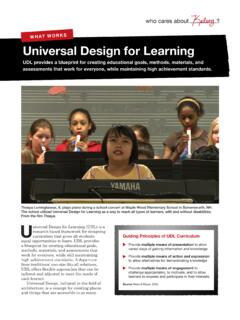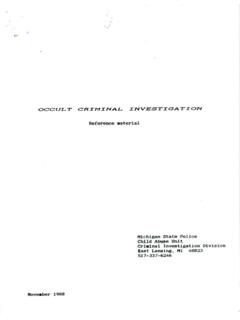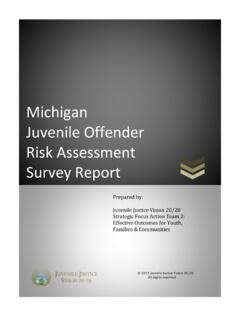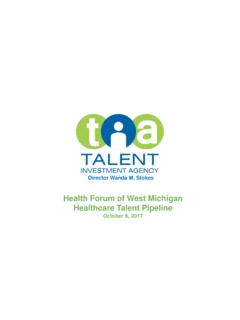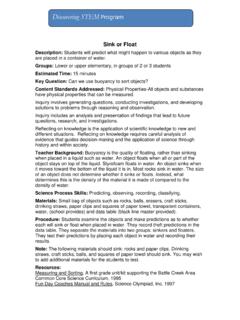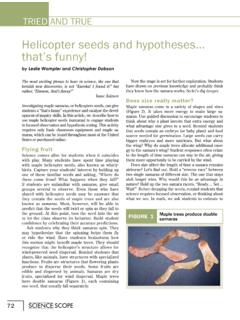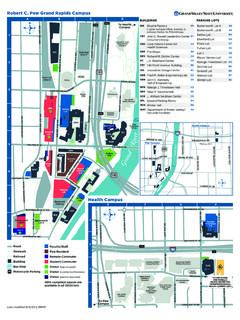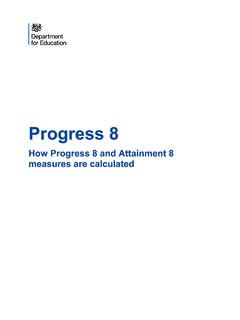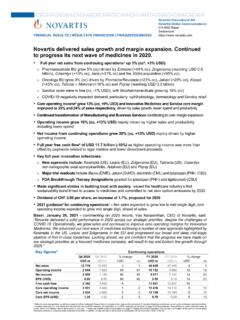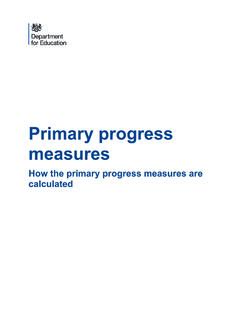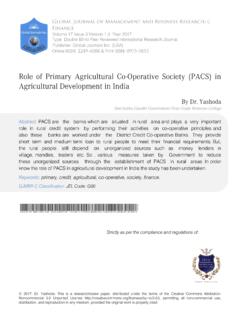Transcription of Structure, Process, and Outcomes: The Foundation for ...
1 Grand Valley State UniversityScholarWorks@GVSUD octoral ProjectsKirkhof College of Nursing4-2018 Structure, process , and Outcomes: The Foundationfor Continuous Quality Improvement in PrimaryCareMark A. ContrerasGrand Valley State University, this and additional works at: of theNursing CommonsThis Project is brought to you for free and open access by the Kirkhof College of Nursing at It has been accepted for inclusion inDoctoral Projects by an authorized administrator of For more information, please CitationContreras, Mark A., "Structure, process , and Outcomes: The Foundation for Continuous Quality Improvement in Primary Care"(2018).Doctoral Projects. head: QUALITY IMPROVEMENT 1 Structure, process , and Outcomes: The Foundation for Continuous Quality Improvement in Primary Care Mark A.
2 Contreras Kirkhof College of Nursing Grand Valley State University Advisor: Dianne Conrad, DNP, FNAP, FNP-BC, CDE, BC-ADM Project Team: Tricia Thomas, PhD, MSN, RN, FACHE, NEA-BC, ACNS-BC, CNL Darleen Hoffert, DNP, RN, AGNP-C QUALITY IMPROVEMENT 2 Abstract Healthcare within the United States is notoriously fragmented and inefficient. Contemporary innovations for policy, reimbursement, and care delivery are consistently directed towards the promotion of value based care (Bates, 2010). These initiatives routinely coalesce around the promising potential of a robust primary care system. The Patient-Centered Medical Home (PCMH) model is increasingly becoming the standard of quality care and use of this model by healthcare providers is poised to bring about a paradigm shift towards value-based care (Henderson, Princell & Martin, 2012).
3 This scholarly project incorporated an evidence based approach to establishing continuous quality improvement in a primary care office pursuing PCMH recognition. Application of The Donabedian Model (Donabedian, 1998) and PARiHS framework (Kitson, Harvey, & McCormack, 1998) provided a strategic approach to developing and successfully adopting the Foundation for continuous quality improvement. This project demonstrated how addressing the fundamental need for supportive structure and process improvements, based upon evidence and the context of an organization, can facilitate the successful adoption of continuous quality improvement (QI) in a Midwest primary care clinic. Systematic efforts to address issues of structure, process , and outcomes for a nurse-managed health center translated to improvement in quality performance scores for cervical cancer screening, breast cancer screening, and tobacco cessation counseling rates.
4 Staff perceptions of organizational QI strategy also improved following implementation. Alternative revenue through incentivized reimbursements went unchanged, but an extended implementation period would likely foster an increase in the relative fiscal benefits of continuous quality improvement. Additionally, several unplanned benefits, including increased number of new patients establishing care at the practice, were actualized QUALITY IMPROVEMENT 3 through organizational engagement in quality improvement work. Ultimately, this project demonstrated how addressing the fundamental need for supportive structure and process improvements, based upon evidence and the context of an organization, can impact outcomes and facilitate the successful adoption of continuous quality improvement in a nurse-managed primary care clinic.
5 QUALITY IMPROVEMENT 4 Table of Contents Executive Summary ..6 Introduction and Background ..11 Patient Centered Medical Home ..12 Value Based Reimbursement ..13 Continuous Quality Problem Evidence-Based Initiative ..16 Patient-Centered Medical Home Quality Preventative Care ..18 Chronic Disease Management ..19 Acute Care Utilization ..20 Implementation Strategies ..21 Establish Meaning for the Initiative ..21 Driving Change with Data ..22 Consistently Engage Staff ..22 Dedicated Time to Accomplish Work ..23 Conceptual Donabedian Model ..24 Structure ..24 process ..26 Outcomes ..27 PARIHS Framework ..28 Evidence ..28 Context ..29 Facilitation ..30 Need and Feasibility Assessment of Organization ..31 Project Plan.
6 32 Purpose of Project ..32 Objectives ..32 Type of Project ..33 Setting and Needed Resources ..33 Design for Evidence-based Initiative ..34 Evidence ..34 Context ..36 Facilitation ..37 Participants ..38 Measure: Source of Data and Tools ..38 Steps for Project Development and Implementation ..39 Ethics and Human Subjects Protection ..41 Budget ..41 Stakeholder Support and Sustainability ..42 Project Evaluation ..42 Project Outcomes ..44 Structure for Quality Improvement ..44 process Improvement ..47 QUALITY IMPROVEMENT 5 outcome Implications for Practice ..51 Implications for the Nursing Procession ..54 Sustainability ..55 Limitations ..56 Reflection on Enactment of DNP Essentials ..57 DNP Essential I: Scientific Underpinnings for Practice.
7 57 DNP Essential II: Organization and Systems Leadership for Quality Improvement ..58 DNP Essential III: Clinical Scholarship and Analytical Methods for Evidence-based Practice ..58 DNP Essential IV: Information Systems/Technology and Patient Care Technology for the Improvement and Transformation of Health Care ..59 DNP Essential V: Health Care Policy for Advocacy in Health Care ..59 DNP Essential VI: Interprofessional Collaboration for Improving Patient and Population Health Outcomes ..60 DNP Essential VII: Clinical Prevention and Population Health for Improving the Nation s Health ..60 DNP Essential VIII: Advanced Nursing Practice ..61 Plan for Dissemination of Outcomes ..61 Conclusion ..61 References ..63 Appendices.
8 71 QUALITY IMPROVEMENT 6 Executive Summary Healthcare within the United States is notoriously fragmented and inefficient. Contemporary innovations for policy, reimbursement, and care delivery are consistently directed towards the promotion of value based care (Bates, 2010). These initiatives routinely coalesce around the promising potential of a robust primary care system. The Patient-Centered Medical Home (PCMH) model is increasingly becoming the standard of quality care and use of this model by healthcare providers is poised to bring about a paradigm shift towards value-based care (Henderson, Princell & Martin, 2012). The PCMH is a comprehensive approach to care delivery predicated upon continuous quality and safety.
9 An empirical base exists to suggest that the successful adoption of a strategy for continuous quality improvement (QI), such as that of the PCMH, by a primary care organization can positively impact the quality of care (Friedberg, Rosenthal, Werner, Volpp, & Schneider, 2015; Savage, Lauby & Burkard, 2013). This type of care delivery redesign can begin the formative work of preparing a primary care practice for the inevitable transition payers will make towards quality based reimbursement models ((Nielsen, Buelt, Patel & Nichols, 2016). Certainly, the transformative work such of adopting continuous quality improvement is not to be misrepresented as a simple endeavor. Application of The Donabedian Model (Donabedian, 1998) and PARiHS Framework (Kitson, Harvey, & McCormack, 1998) provided a strategic approach to successfully adopting a continuous QI model.)
10 This project aimed to answer the clinical question - how does an evidence-based approach to comprehensive QI, emphasizing structure, process , and outcomes, impact staff perceptions of QI, adoption of process efficiencies, and organizational performance as measured by HEDIS metrics and incentivized reimbursement? QUALITY IMPROVEMENT 7 This scholarly project identified the need to develop structural support for continuous QI. Consideration to organizational structure was intentionally incorporated by utilizing the patient care technology system and fostering staff knowledge and the explicit roles required to support continuous QI. Given the inherent complexities of organizational change, the importance of establishing a QI culture was also a primary structural consideration during project development.
